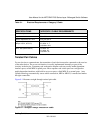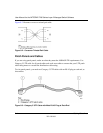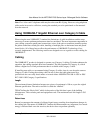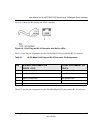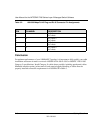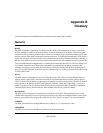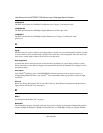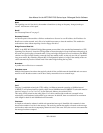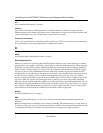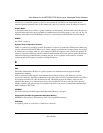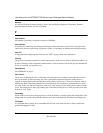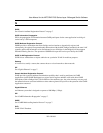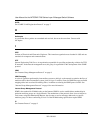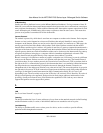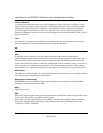
User Manual for the NETGEAR 7200 Series Layer 2 Managed Switch Software
Glossary B-3
202-10010-01
Baud
The signaling rate of a line, that is, the number of transitions (voltage or frequency changes) made per
second. Also known as line speed.
BootP
See “Bootstrap Protocol” on page 3.
Bootstrap Protocol
An Internet protocol that enables a diskless workstation to discover its own IP address, the IP address of a
BootP server on the network, and a file to be loaded into memory to boot the machine. This enables the
workstation to boot without requiring a hard or floppy disk drive.
Bridge Protocol Data Unit
BPDU is the IEEE 802.1D MAC Bridge Management protocol that is the standard implementation of STP
(Spanning Tree Protocol). It uses the STP algorithm to insure that physical loops in the network topology do
not result in logical looping of network traffic. Using one bridge configured as root for reference, the BPDU
switches one of two bridges forming a network loop into standby mode, so that only one side of a potential
loop passes traffic. By examining frequent 802.1d configuration updates, a bridge in the standby mode can
switch automatically into the forward mode if the other bridge forming the loop fails.
Broadcast
A packet sent to all devices on a network.
Broadcast storm
Multiple simultaneous broadcasts that typically absorb all the available network bandwidth and can cause a
network to fail. Broadcast storms can be due to faulty network devices or network loops.
C
Cat 5
Category 5 unshielded twisted pair (UTP) cabling. An Ethernet network operating at 10 Mbits/second
(10BASE-T) will often tolerate low quality cables, but at 100 Mbits/second (10BASE-Tx) the cable must be
rated as Category 5, or Cat 5 or Cat V, by the Electronic Industry Association (EIA).
This rating will be printed on the cable jacket. Cat 5 cable contains eight conductors, arranged in four
twisted pairs, and terminated with an RJ45 type connector. In addition, there are restrictions on maximum
cable length for both 10 and 100 Mbits/second networks.
Checksum
A simple error-detection scheme in which each transmitted message is identified with a numerical value
based on the number of set bits in the message. The receiving station then applies a formula to the message
and checks to make sure the accompanying numerical value is the same. If not, the receiver can assume that
the message has been corrupted.



